核心内容:
1、C语言指针的核心知识点
2、处理指针相干问题的万能措施—-内存分配图
3、C语言的指针是如何过渡到Java中的援用的
最近1段时间1直在学习C语言的指针,也算是很有心得吧,虽然从网上看了几篇关于指针的博文,但是感觉都不符合自己的口味,因而决定好好写1篇关于指针的文章。
C语言指针的核心知识点:
1、指针就是地址,地址就是内存单元的编号,范围是0到4G⑴,指针的本质就是1个操作受限的非负整数,而指针变量就是寄存内存单元编号(即地址、指针)的变量。
2、凡是动态分配的内存,都是没着名字的,而是将其地址赋给1个指针变量,用指针变量去代表这个事物。
3、1个指针变量,不管其指向的变量占多少个字节,其本身只占用4个字节的内存空间,由于内存单元的编号是32位。32/8=4
4、字节是存储数据的基本单元,1个字节占8位,而1个字节的编号占32位。
5、变量分为两种类型:普通类型变量和指针类型变量,其中普通类型变量用来寄存真实的数据,而指针类型变量用来寄存变量的地址。其中指针类型变量包括(Java中):
①所有类定义的变量:如 Student student = new Student(“zhang” , 25),其中的student
②所有接口定义的变量:如 List list = new ArrayList(),其中的list
③数组的名字:如int a[] = {1,2,3,8,9}中的a。
6、静态内存是在栈中进行分配的,是由系统自动分配、自动释放的,静态内存是程序员没法控制的;动态内存是在堆中进行分配的,是由程序员手动分配,手动释放的,凡是动态分配的内存必须通过free的方式才能够进行释放,固然这里指的是C语言;在Java当中,动态分配的内存是由内存回收机制来回收的,不用程序员来进行手动回收,保证了程序的安全性,但是在Java当中,由于虚拟机要1直跟踪每块内存空间的使用情况,所以常常会从造成CPU的使用率过大。
好的,如果你想学会C语言中的指针,上面的这些内容是你必须要理解的,首先我们先理解1下究竟甚么是指针,在理解究竟甚么是指针之前,我们必须要知道数据在内存中究竟是如何来进行存储的,先放1张图:

这里通过1个小例子来讲明数据在内存中是如何来进行存储的:
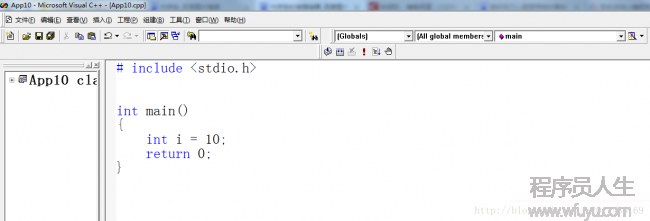
当我们在Visiual C++6.0软件对这个程序进行编译运行的时候,Visiual C++6.0这个软件首先要求操作系统为我们的变量i分配1块内存空间,随后操作系统会在内存中寻觅1块空闲的区域分配给我们的程序,随后Visiual C++6.0这个软件会将变量i和我们的这块内存空间关联起来,今后对变量i的操作就是对我们内存空间的操作。具体实现进程以下:

现在我们对内存存储的这1块区域进行放大:
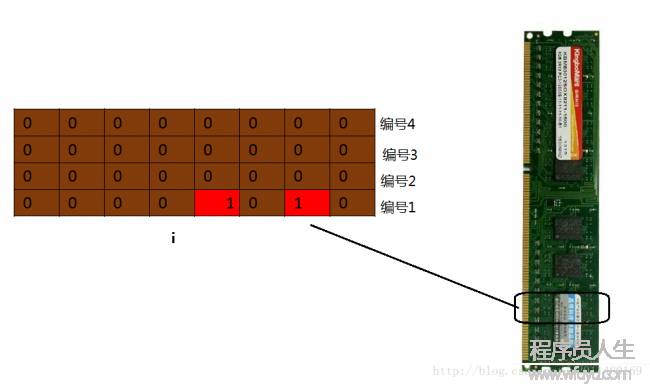
操作系统会给我们的变量分配1块内存空间,但是这块内存空间究竟在内存中的甚么位置呢?这块内存空间在内存空间中的编号究竟是多少呢?现在让我么在程序中输出1下:
# include <stdio.h>
int main()
{
int i = 10;
printf("编号1的数值是:%#X\n",&i);
return 0;
}运行结果:

现在我们用图画在描写1下:

在上面这张图中: (即编号1)就是我们所说的指针,即地址,也就是说:指针实际上就是内存单元的编号,1个编号为32位,每个内存单元都会占有1个内部单元的编号(即地址)记载其在内存条中的位置,因此通过指针我们可以直接对硬件进行操作。
(即编号1)就是我们所说的指针,即地址,也就是说:指针实际上就是内存单元的编号,1个编号为32位,每个内存单元都会占有1个内部单元的编号(即地址)记载其在内存条中的位置,因此通过指针我们可以直接对硬件进行操作。
其实,程序归根结柢就是对内存的操作,我们对1块内存空间进行操作总共含有两种方式:
①直接通过变量名的方式对这块内存空间进行操作。(直接访问)
②通过获得内存空间的地址对这块内存空间进行操作。(间接访问)

其中,第1种方式是我们常常使用的,但是第2种方式会让我们有1种直接接触到硬件的感觉,示例程序:
# include <stdio.h>
int main()
{
int i = 10;
printf("编号1的数值是:%#X\n",&i);
int * p = &i; //指针变量p保存了变量i的地址:18FF44
*p = 100; //以18FF44为地址的那块内存空间的内容设置为100
printf("变量i的内容是:%d\n",i);//不管是直接访问还是以地址的间接访问,本质上都是对同1块内存空间的访问
return 0;
}运行结果:
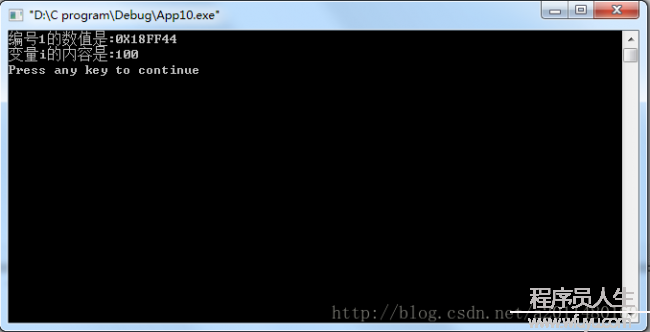
具体效果:
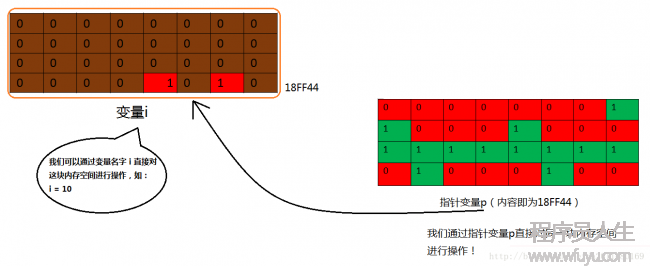
归根接地就是1句话:不管是通过变量名i的直接访问,还是通过地址18FF44的间接访问,本质上都是对同1块内存空间的访问。
处理指针相干问题的万能措施—-内存分配图
很多人在处理指针这块的程序的时候,有的时候总是会感觉到很迷糊,但是就我个人而言,对指针相干的知识,总是习惯于去画内存分配图去解决问题,而且效果还是非常好的,下面我们就用1个典型的程序:交换内容的程序来讲明问题。
要求:输入a和b两个整数,依照先大后小的顺序输出a和b。
实例程序1:
# include <stdio.h>
void swap(int ,int );
int main()
{
int a,b;
printf("请从键盘上输入a和b两个数值:\n");
scanf("%d %d",&a,&b);
if (a < b)
{
swap(a,b);
}
printf("max=%d \t min=%d \n",a,b);
return 0;
}
void swap(int p,int q)
{
int tmp; //交换p和q的内容
tmp = p;
p = q;
q = tmp;
}运行结果:
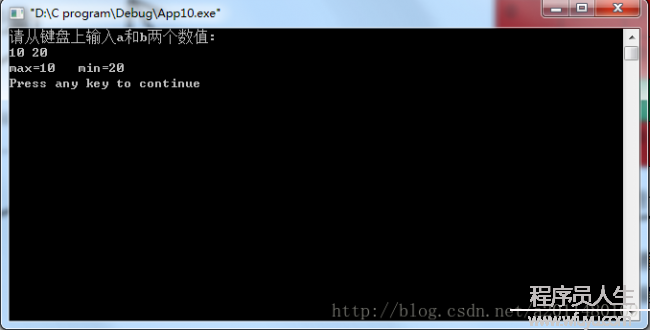
很明显,从运行结果上来看,并没有到达我们的预期效果,下面我们用内存分配图来查找1下缘由:
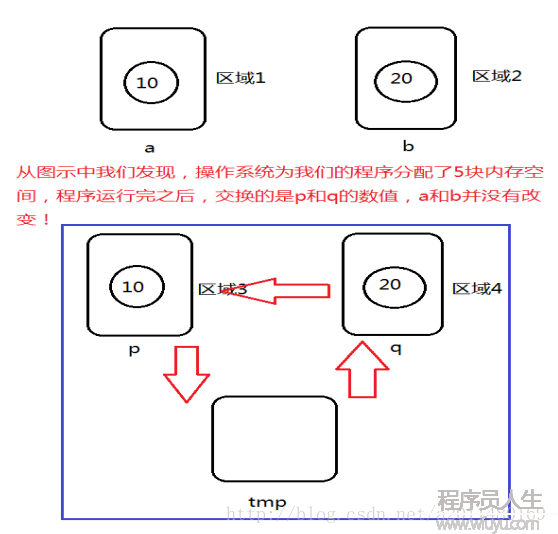
所以上面程序的解法是毛病的。
实例程序2:
# include <stdio.h>
void swap(int *,int *);
int main()
{
int a,b;
printf("请从键盘上输入a和b两个数值:\n");
scanf("%d %d",&a,&b);
if (a < b)
{
swap(&a,&b);
}
printf("max=%d \t min=%d \n",a,b);
return 0;
}
void swap(int *p,int *q)
{
int tmp;
tmp = *p;
*p = *q;
*q = tmp;
}运行结果:
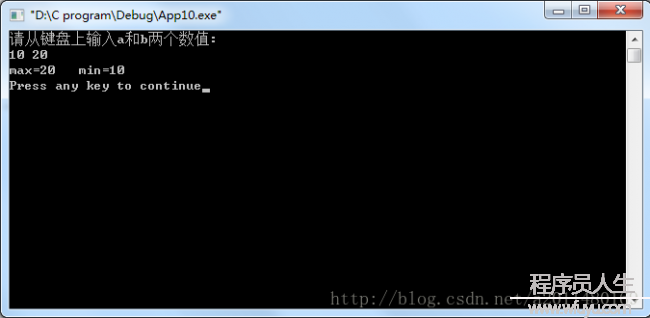
内存分配图:
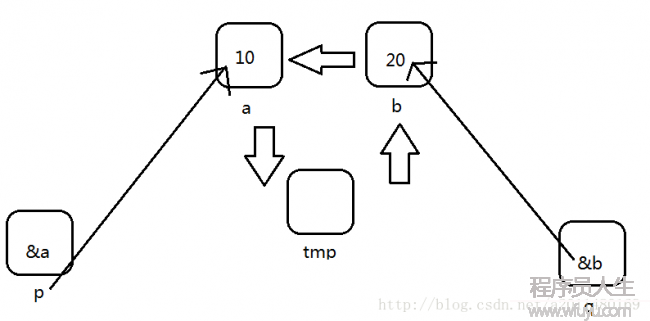
通过上面的图解我们可以发现,指针变量p和q分别定位到了变量a和变量b的内存空间,间接的交换了a和b内存空间的内容。
C语言的指针是如何过渡到Java中的援用的
在谈到这个问题的时候,我认为应当从两个方面进行说起:动态内存分配和如何传递发送内容。
动态内存份分配的问题:
实例程序1:
# include <stdio.h>
# include <malloc.h>
# include <string.h>
struct Student
{
char name[100];
int age;
float score;
};
int main()
{
Student * student = (Student *)malloc(sizeof(Student));
strcpy(student->name,"zhangming");
student->age = 25;
student->score = 88.8f;
printf("name is %s\n",student->name); //student->age在编译底层会变成(*student).name
printf("age is %d\n",student->age);
printf("score is %f\n",student->score);
return 0;
}运行结果:
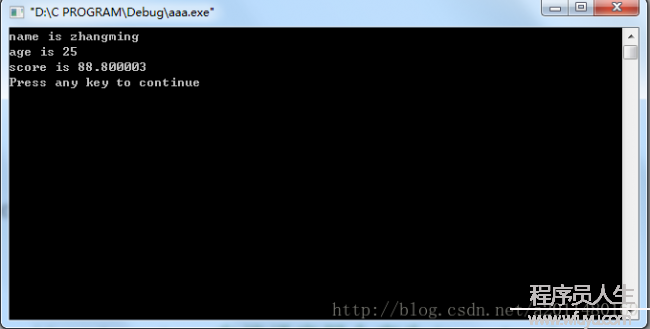
内存实例图示:
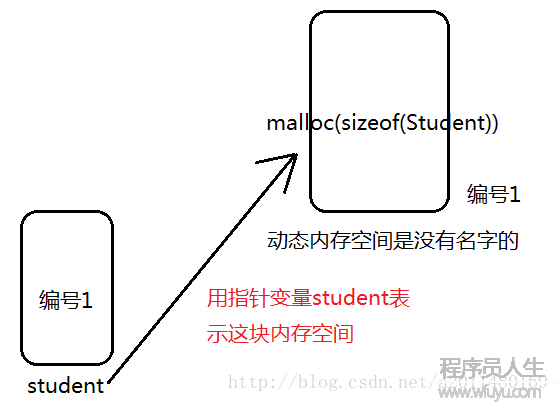
对上面的这个程序,Java语言是这么封装的:
class Student
{
String name;
int age;
float score;
}
public class App1
{
public static void main(String[] args)
{
//Student * student = (Student *)malloc(sizeof(Student));
Student student = new Student(); //new相当于C语言中的malloc
student.name = "zhangsan";
student.age = 25;
student.score = 88.8f;
System.out.println("name is:"+student.name);
System.out.println("age is:"+student.age);
System.out.println("score is:"+student.score);
}
}下面我们通过函数传递数据:传递指针变量(本质传递的是地址)
# include <stdio.h>
# include <malloc.h>
# include <string.h>
struct Student
{
char name[100];
int age;
float score;
};
void changeData(Student * stu)
{
strcpy(stu->name,"lisi");
stu->age = 24;
stu->score = 98.8f;
}
int main()
{
Student * student = (Student *)malloc(sizeof(Student));
strcpy(student->name,"zhangming");
student->age = 25;
student->score = 88.8f;
printf("name is %s\n",student->name); //student->age在编译底层会变成(*student).name
printf("age is %d\n",student->age);
printf("score is %f\n",student->score);
changeData(student);//传递的是地址,速度快并且节省内存空间!
printf("name is %s\n",student->name); //student->age在编译底层会变成(*student).name
printf("age is %d\n",student->age);
printf("score is %f\n",student->score);
return 0;
}运行结果:

Java封装的效果:
class Student
{
String name;
int age;
float score;
}
public class App1
{
public static void main(String[] args)
{
//Student * student = (Student *)malloc(sizeof(Student));
Student student = new Student(); //new相当于C语言中的malloc
student.name = "zhangsan";
student.age = 25;
student.score = 88.8f;
System.out.println("name is:"+student.name);
System.out.println("age is:"+student.age);
System.out.println("score is:"+student.score);
changeData(student); //student本质上是1个指针变量
System.out.println("name is:"+student.name);
System.out.println("age is:"+student.age);
System.out.println("score is:"+student.score);
}
public static void changeData(Student stu) //stu指向同1块内存空间
{
stu.name = "lisi";
stu.age = 24;
stu.score = 98.8f;
}
}运行结果:
name is:zhangsan
age is:25
score is:88.8
name is:lisi
age is:24
score is:98.8总结:在Java当中,虽然已没有了指针,但是底层编译运行进程中本质上就是指针,Java中的援用本质上就是C语言中的指针变量,不管是C语言还是Java语言,都有1个共同的特点:凡是动态分配的内存都是没着名字的,而是用1个指针变量保存这块内存空间的地址,用这个指针变量去代表这块内存空间。
OK,博文如果有问题,欢迎大家留言指正!
